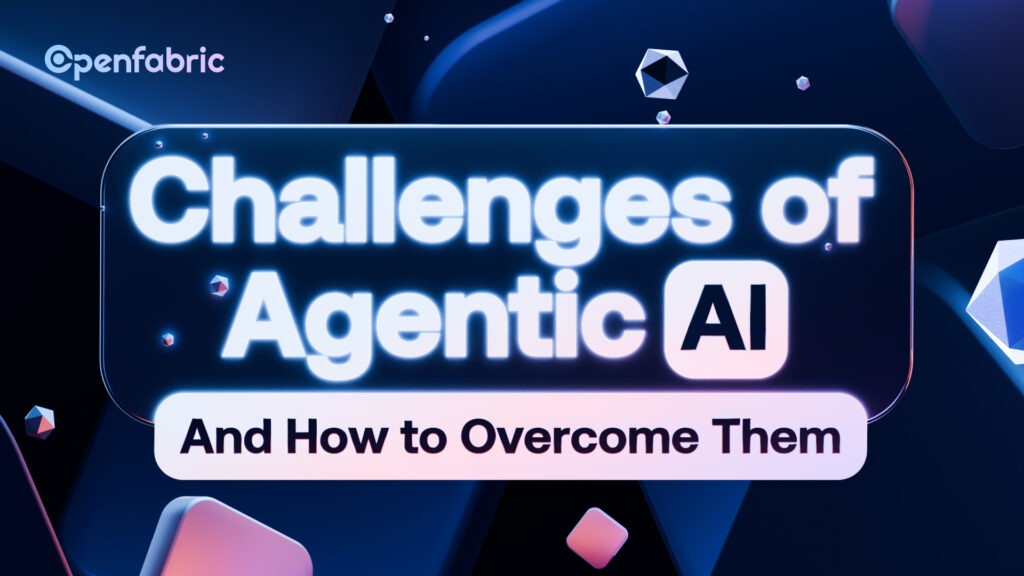
June 6, 2025 6 minutes read
The Rise of Agentic AI: Challenges of Agentic AI and How to Overcome Them

All through the age of artificial intelligence we have known and are familiar with only one type of AI system. This nature of AI operates within specific confined parameters, and most of the time requires extensive human intervention. However, the original aim of AI is to be autonomous in its specific application. With this in mind, out went “traditional AI” and in came “agentic AI”. This development made AI evolve into a more autonomous model. However, this innovation brought the challenges of agentic AI that constrain its wide use.
Fortunately, there are ways to overcome these challenges of agentic AI. To know how to navigate the challenges of any technology, a basic understanding of what it is and how it works is crucial. Therefore, in this article, we will briefly learn about agentic AI, unveil its challenges, and discover creative ways with which we can navigate these challenges without compromising the original functions of the AI model.
Let’s get started!
What is agentic AI?
Agentic AI is an artificial intelligence system that can achieve a specific goal with little or no human intervention or supervision. There are many frames and frameworks of agentic AI, however, the basis of its working is that it uses generative AI techniques and modifies it using large language models (LLMs) so that it can function anywhere including a dynamic environment.
Simply put, it takes the results or working principles of generative AI and applies them in a different but relevant scenario to achieve a specific goal. For example, generative AI will tell you the best time to go skiing in the Alps, but agentic AI goes further and even uses external tools to find good deals in choice hotels and affordable options. It can also help you plan out your itinerary, taxi services, and other services to make your stay more comfortable. Agentic AI makes artificial intelligence more than just a generative tool, it brings it into the real world to solve real-world problems.
How does agentic AI work?
Agentic AI tools are used in various settings and industries where they solve different problems. However, the general mechanisms by which they work include the following steps:
- Comprehensive data collection from its environment using sensors, APIs, databases, or simply from human interactions. This first step is essential in ensuring that the system has up-to-date information to work with.
- Using natural language processing (NLP), and other AI capabilities, agentic AI processes the data it has collected and uses it to analyze queries, understand them, and provide the relevant information. Through pattern detection, agentic AI can determine what actions to take next based on the situation without human intervention.
- Agentic AI uses predefined goals or previous user inputs to set goals. Thereafter, it creates strategies to achieve these set goals by using decision trees or other planning algorithms.
- With minimal human guidance, agentic AI makes decisions based on previously recognized patterns. It takes these patterns, evaluates multiple possible actions and their results, and chooses the best one based on how efficient it is in achieving set goals.
- Agentic AI keeps working to improve and be better by continuous learning and adaptation. After executing its action, the AI analyzes the outcome and learns to improve its future actions through self-supervised learning. Over time, it continuously refines its strategies and becomes more effective in handling similar tasks in the future.
Challenges of agentic AI systems
Agentic AI systems have a great potential to transform the way we carry out everyday activities. However, this great potential is also associated with some challenges of agentic AI. Let us discuss some of these challenges.
Ethical problems
Due to its autonomy, some decisions made by agentic AI systems may lack that human touch and the outcome can be unfair or unethical. If these AI systems are trained on biased data, there may be a reinforcement of existing biases which may be unfair to vulnerable groups.
Lack of transparency and responsibility
In a situation where ethical biases from an agentic AI system lead to severe consequences, it becomes unclear who to hold responsible for the failure. Some may argue that the engineers responsible for training the model be held accountable, however, biases in agentic AI systems may be an accumulation of multiple biases from multiple sources. Read more about AI biases.
In addition, the workings of agentic AI systems are not very clear, especially to individuals without AI training. As such, people are often confused about how decisions are made by the algorithm.
Technical malfunctions
Several technical malfunctions hinder the full potential of agentic AI systems. For example, since agentic AI uses self-supervised or reinforcement learning, which focuses on reward function, a poorly designed reward system gives the AI system an opportunity to find and exploit loopholes to achieve outcomes in unintended ways.
Furthermore, some agentic AI systems may become self-reinforcing and optimize a metric too aggressively without checks. This often escalates certain behaviors in an unintended direction and may lead to the failure of the AI system.
Multiple points of failure
Agentic AI systems are often made up of multiple autonomous AI agents working together and as such, there are multiple points of failure. Errors that may occur due to a single-point failure of any of these agents may be caused by traffic jams or conflict in resource allocation.
How to overcome the challenges of agentic AI systems?
Before deploying any AI agent, some issues must be addressed to ensure that they function well and that the challenges of agentic AI systems are avoided. By addressing these issues, you are ensuring smooth sailing for the system. Here are some steps to take:
- Training of AI agents with quality and relevant data to avoid biases.
- Implementing segmentation protocols and anonymizing sensitive information to ensure data privacy and security.
- Have clearly defined and well-grounded goals.
- Providing clear documentation of automation processes, compliance considerations, and decision logic to help build transparency.
- Implementation of feedback loops so that the model can move closer to the intended goals over time.
Addressing the challenges of agentic AI at Openfabric
Openfabric AI is a revolutionary AI platform that gives AI developers the home to develop innovative AI tools. It is a decentralized Layer 1 platform that already addresses the challenge of data privacy and security. Openfabric has already developed over 80 AI agents with applications in various industrial sectors. These tools not only generate results but also show you the next steps to take and some of them include; Openfabric AI trading bot, AI genome generator, Drug discovery app. To discover more, visit our MARKETPLACE where you can explore and get access to all these tools.
Conclusion
Agentic AI is still a new technology compared to others. As such, there are still some challenges that may limit its use in everyday life. Navigating these challenges is key to ensuring that we can fully maximize the potential of this technology and ensure their smooth operation wherever they are set up. The challenges of agentic AI systems are not hindrances to their use. Rather, they are stepping stones to the next level of AI development and adoption.
For more insights and AI-related information, visit our WEBSITE today!

